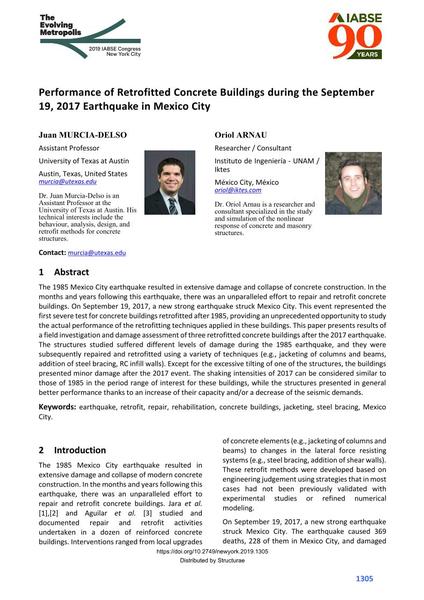Performance of Retrofitted Concrete Buildings during the September 19, 2017 Earthquake in Mexico City

|
|
|||||||||||
Détails bibliographiques
| Auteur(s): |
Juan Murcia-Delso
(University of Texas at Austin)
Oriol Arnau (Instituto de Ingeniería - UNAM; Iktes) |
||||
|---|---|---|---|---|---|
| Médium: | papier de conférence | ||||
| Langue(s): | anglais | ||||
| Conférence: | IABSE Congress: The Evolving Metropolis, New York, NY, USA, 4-6 September 2019 | ||||
| Publié dans: | The Evolving Metropolis | ||||
|
|||||
| Page(s): | 1305-1313 | ||||
| Nombre total de pages (du PDF): | 9 | ||||
| DOI: | 10.2749/newyork.2019.1305 | ||||
| Abstrait: |
The 1985 Mexico City earthquake resulted in extensive damage and collapse of concrete construction. In the months and years following this earthquake, there was an unparalleled effort to repair and retrofit concrete buildings. On September 19, 2017, a new strong earthquake struck Mexico City. This event represented the first severe test for concrete buildings retrofitted after 1985, providing an unprecedented opportunity to study the actual performance of the retrofitting techniques applied in these buildings. This paper presents results of a field investigation and damage assessment of three retrofitted concrete buildings after the 2017 earthquake. The structures studied suffered different levels of damage during the 1985 earthquake, and they were subsequently repaired and retrofitted using a variety of techniques (e.g., jacketing of columns and beams, addition of steel bracing, RC infill walls). Except for the excessive tilting of one of the structures, the buildings presented minor damage after the 2017 event. The shaking intensities of 2017 can be considered similar to those of 1985 in the period range of interest for these buildings, while the structures presented in general better performance thanks to an increase of their capacity and/or a decrease of the seismic demands. |
||||
| Mots-clé: |
tremblement de terre retrofit
|
||||
